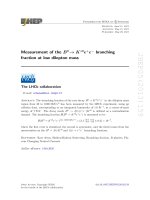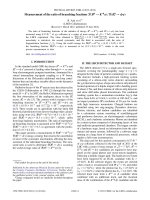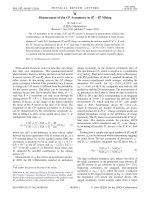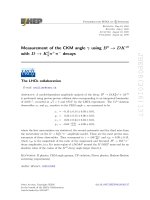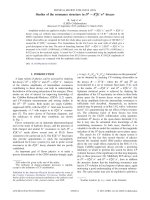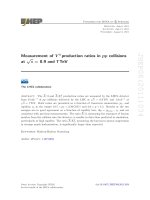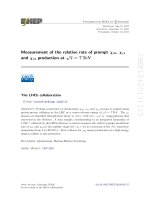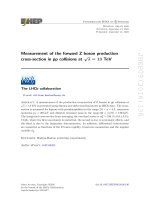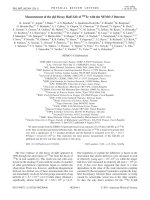DSpace at VNU: Measurement of the CP Asymmetry in B-s(0) - (0)(s) Mixing
Bạn đang xem bản rút gọn của tài liệu. Xem và tải ngay bản đầy đủ của tài liệu tại đây (698.63 KB, 9 trang )
PRL 117, 061803 (2016)
week ending
5 AUGUST 2016
PHYSICAL REVIEW LETTERS
Measurement of the CP Asymmetry in B0s − B¯ 0s Mixing
R. Aaij et al.*
(LHCb Collaboration)
(Received 1 June 2016; published 5 August 2016)
The CP asymmetry in the mixing of B0s and B¯ 0s mesons is measured in proton-proton collision data
corresponding to an integrated luminosity of 3.0 fb−1 , recorded by the LHCb experiment at center-of-mass
ð−Þ
Æ
energies of 7 and 8 TeV. Semileptonic B0s and B¯ 0s decays are studied in the inclusive mode D∓
s μ ν μ X with
∓
the Ds mesons reconstructed in the K þ K − π ∓ final state. Correcting the observed charge asymmetry for
detection and background effects, the CP asymmetry is found to be assl ¼ ð0.39 Æ 0.26 Æ 0.20Þ%, where the
first uncertainty is statistical and the second systematic. This is the most precise measurement of assl to date. It
is consistent with the prediction from the standard model and will constrain new models of particle physics.
DOI: 10.1103/PhysRevLett.117.061803
When neutral B mesons evolve in time they can change
into their own antiparticles. This quantum-mechanical
phenomenon is known as mixing and occurs in both neutral
B meson systems, B0 and B0s , where B is used to refer to
either system. In this mixing process, the CP (chargeparity) symmetry is broken if the probability for a B meson
to change into a B¯ meson is different from the probability
for the reverse process. This effect can be measured by
studying decays into flavor-specific final states, B → f,
such that B¯ → f transitions can only occur through the
mixing process B¯ → B → f. Such processes include semileptonic B decays, as the charge of the lepton identifies
the flavor of the B meson at the time of its decay. The
magnitude of the CP-violating asymmetry in B mixing
can be characterized by the semileptonic asymmetry asl.
This is defined in terms of the partial decay rates, Γ, to
semileptonic final states as
asl ≡
¯
ΓðB¯ → fÞ − ΓðB → fÞ
ΔΓ
≈
tan ϕ12 ;
¯
¯
ΓðB → fÞ þ ΓðB → fÞ Δm
ð1Þ
where Δm (ΔΓ) is the difference in mass (decay width)
between the mass eigenstates of the B system and ϕ12 is a
CP-violating phase [1]. In the standard model (SM), the
asymmetry is predicted to be as small as adsl ¼ ð−4.7 Æ
0.6Þ × 10−4 in the B0 system and assl ¼ ð2.22 Æ 0.27Þ ×
10−5 in the B0s system [1,2]. However, these values may
be enhanced by non-SM contributions to the mixing
process [3].
Measurements of asl have led to an inconclusive picture.
In 2010, the D0 Collaboration reported an anomalous
*
Full author list given at the end of the article.
Published by the American Physical Society under the terms of
the Creative Commons Attribution 3.0 License. Further distribution of this work must maintain attribution to the author(s) and
the published article’s title, journal citation, and DOI.
0031-9007=16=117(6)=061803(9)
charge asymmetry in the inclusive production rates of
like-sign dimuons [4], which is sensitive to a combination
of adsl and assl . Their most recent study shows a discrepancy
with SM predictions of about 3 standard deviations [5].
The current experimental world averages, excluding the
anomalous D0 result, are adsl ¼ ð0.01 Æ 0.20Þ% and
assl ¼ ð−0.48 Æ 0.48Þ% [6], compatible with both the SM
predictions and the D0 measurement. The measurement of
assl presented in this Letter is based on data recorded by
LHCb in 2011 and 2012, corresponding to an integrated
luminosity of 3.0 fb−1 . It supersedes the previous LHCb
measurement [7], which used the 1.0 fb−1 data sample
taken in 2011. Semileptonic decays B0s → D−s μþ νμ X,
where X represents any number of particles, are reconstructed inclusively in D−s μþ . Charge-conjugate modes are
implied throughout, except in the definitions of charge
asymmetry. The D−s meson is reconstructed in the K þ K − π −
final state. This analysis extends the previous LHCb
measurement, which considered only D−s → ϕπ − decays,
by including all possible D−s decays to the K þ K − π − final
state.
Starting from a sample with equal numbers of B0s and B¯ 0s
mesons, assl can be measured without determining (tagging)
the initial flavor. The raw asymmetry of observed D−s μþ
−
0
and Dþ
s μ candidates, integrated over Bs decay time, is
Araw ¼
−
NðD−s μþ Þ − NðDþ
s μ Þ
− :
NðD−s μþ Þ þ NðDþ
s μ Þ
ð2Þ
The high oscillation frequency Δms reduces the effect of
the small asymmetry in the production rates between B0s
and B¯ 0s mesons in pp collisions by a factor 10−3 [7,8].
Neglecting corrections, the untagged, time-integrated
asymmetry is Araw ¼ assl =2, where the factor 2 reduction
compared to the tagged asymmetry in Eq. (1) comes from
the summation over mixed and unmixed decays. The
tagged asymmetry would actually suffer from a larger
061803-1
© 2016 CERN, for the LHCb Collaboration
week ending
5 AUGUST 2016
PHYSICAL REVIEW LETTERS
φπ
2.5
LHCb
±
D s → K ±K π
2
103
NR
102
1.5
±
m2(K ±π ) [GeV2/ c4]
±
reduction because of the tagging efficiency [9,10]. The
unmixed decays have zero asymmetry due to CPT symmetry. The raw asymmetry is still affected by possible
differences in detection efficiency for the two chargeconjugate final states and by backgrounds from other
b-hadron decays to D−s μþ X. Hence, assl is calculated as
±
PRL 117, 061803 (2016)
2
ðA − Adet − f bkg Abkg Þ;
1 − f bkg raw
ð3Þ
where Adet is the detection asymmetry, which is assessed
from data using calibration samples, f bkg is the fraction
of the b-hadron background, and Abkg the background
asymmetry.
The LHCb detector is a single-arm forward spectrometer
designed for the study of particles containing b or c quarks
[11,12]. A high-precision tracking system with a dipole
magnet measures the momentum (p) and impact parameter
(IP) of charged particles. The IP is defined as the distance of
closest approach between the track and any primary protonproton interaction and is used to distinguish between
D−s mesons from B decays and D−s mesons promptly
produced in the primary interaction. The regular reversal
of the magnet polarity allows a quantitative assessment of
detector-induced charge asymmetries. Different types
of charged particles are distinguished using particle
identification (PID) information from two ring-imaging
Cherenkov detectors, an electromagnetic calorimeter, a
hadronic calorimeter and a muon system. Online event
selection is performed by a two-stage trigger. For this
analysis, the first (hardware) stage selects muons in the
muon system; the second (software) stage applies a full
event reconstruction. Here the events are first selected by
the presence of the muon or one of the hadrons from the D−s
decay, after which a combination of the decay products is
required to be consistent with the topological signature of a
b-hadron decay. Simulated events are produced using the
software described in Refs. [13–17].
Different intermediate states, clearly visible in the Dalitz
plot shown in Fig. 1, contribute to the three-body D−s →
K þ K − π − decays. Three disjoint regions are defined, which
have different levels of background. The ϕπ region is the
cleanest and is selected by requiring the reconstructed K þ
K − mass to be within Æ20 MeV=c2 of the known ϕ mass.
The K Ã K region is selected by requiring the reconstructed
K þ π − mass to be within Æ90 MeV=c2 of the known
K Ã ð892Þ0 mass. The remaining D−s candidates are included
in the non-resonant (NR) region, which also covers other
intermediate states [18].
The D−s candidates are reconstructed from three charged
tracks, and then a muon track with opposite charge is
added. All four tracks are required to have a good quality
track fit and significant IP. The contribution from prompt
D−s background is suppressed to a negligible level by
imposing a lower bound on the IP of the D−s candidates.
1
*
K K
10
0.5
1
1
2
3
±
assl ¼
m2(K ±K ) [GeV2/ c4]
Æ ∓ ∓
FIG. 1. Dalitz plot of the D∓
s → K K π decay for selected
∓ Æ
Ds μ candidates, with the three selection regions indicated. To
suppress combinatorial background, a narrow invariant mass
window, between 1950 and 1990 MeV=c2 , is required for the D∓
s
candidates in this plot.
To ensure a good overlap with the calibration samples,
minimum momenta of 2, 5, and 6 GeV=c and minimum
transverse momenta, pT , of 300, 400, and 1200 MeV=c are
required for the pions, kaons, and muons, respectively.
To suppress background, kaon and pion candidates are
required to be positively identified by the PID system.
Candidates are selected by requiring a good quality of
the D−s and B0s decay vertices. A source of background
arises from D−s candidates where one of the three decay
particles is misidentified. The main contributions are from
¯ −c → K þ pπ
¯ − , D− → K þ π − π − , J=ψX, and misidentified
Λ
or partially reconstructed multibody D decays, all originating from semileptonic b-hadron decays. They are suppressed to a negligible level by specific vetoes, which apply
tight PID requirements in a small window of invariant mass
of the corresponding particle combination. These vetoes are
optimized separately for each Dalitz plot region. To check
that this does not introduce additional asymmetries, these
selections are applied to control samples of promptly
produced D−s mesons. The asymmetries are found to be
consistent between the Dalitz regions.
The D−s μþ signal yields are obtained from fits to the
þ − −
K K π invariant mass distributions. These yields contain
contributions from backgrounds that also peak at the D−s
mass, originating from other b-hadron decays into D−s
mesons and muons. Simulation studies indicate that these
peaking backgrounds are mainly composed of b-hadron
decays to D−s Xc X, where the D−s meson originates from a
b → c¯cs transition, and Xc is a charmed hadron decaying
semileptonically.
¯ 0 X.
An example of such a background is B− → D−s D
þ
− þ þ
Other, smaller contributors are B → Ds K μ νμ X
and B0 → D−s K 0S μþ νμ X decays. All of these peaking
backgrounds have more missing particles than the
061803-2
week ending
5 AUGUST 2016
PHYSICAL REVIEW LETTERS
150
× 103
Candidates / (2.5 MeV/c2)
LHCb
Ds
D
100 φ π
50
1800K *K
60
±
Comb.
1850
40
1900
1950
2000
1950
2000
1900
1950
m(K +K −π ) [MeV/ c2]
2000
-
Minv(K K+π+)_PhiPi (MeV)
20
1800
NR
40
1850
1900
-
Minv(K K+π+)_KStarK (MeV)
20
1800
1850
±
B0s → D−s μþ νμ X signal decay. Their contribution is
reducedpby
requiring
the corrected B0s mass, defined as
ffiffiffiffiffiffiffiffiffiffiffiffiffiffiffiffiffi
ffi
mcorr ≡ m2 þpT 2 þpT , to be larger than 4200 MeV=c2 ,
where m is the D−s μþ invariant mass and pT the D−s μþ
momentum transverse to the line connecting the primary
and B0s decay vertices.
The estimates of f bkg and Abkg are based on known
branching fractions [18], selection efficiencies, and background asymmetries, using a similar approach as in the
previous measurement [7]. The reconstruction and selection efficiencies of the backgrounds relative to the signal
efficiency are determined from simulation. The total background asymmetry
P is given by the sum of all contributions
as f bkg Abkg ≡ i f ibkg Aibkg . The background asymmetries
mainly originate from the production asymmetries of b
hadrons. The production asymmetry between Bþ and B−
mesons is Abkg ðBþ Þ ¼ ð−0.6 Æ 0.6Þ%, obtained from the
observed asymmetry in Bþ → J=ψK þ decays [19], after
correcting for the kaon detection asymmetry and the direct
CP asymmetry [18]. For the B0 background, there are
contributions from the production asymmetry and from
adsl [20]. Both asymmetries are diluted when integrating
over the B0 decay time, resulting in Abkg ðB0 Þ ¼
ð−0.18 Æ 0.13Þ%. The production asymmetry in the Λ0b
backgrounds is estimated based on the combined CP and
production asymmetry measured in Λ0b → J=ψpþ K −
decays [21]. The direct CP asymmetry in this decay mode
is estimated to be ð−0.6 Æ 0.3Þ%, using the measurements
in Ref. [22] and the method proposed in Ref. [23].
Subtracting this from the combined asymmetry [21]
results in Abkg ðΛ0b Þ ¼ ðþ0.5 Æ 0.8Þ%. The overall peaking
background fraction is f bkg ¼ ð18.4 Æ 6.0Þ% and the
correction for the background asymmetry is f bkg Abkg ¼
ð−0.023 Æ 0.031Þ%.
The K þ K − π ∓ mass distributions are shown in Fig. 2,
Æ
with the fit results superimposed. The D∓
s μ yields are
3
found to be 899 × 10 in the ϕπ region, 413 × 103 in the
K Ã K region, and 280 × 103 in the NR region. Extended
maximum likelihood fits are made separately for the three
Dalitz regions, for the two magnet polarities, and the two
data-taking periods (2011 and 2012). To accurately determine the background shape from random combinations of
K þ K − π − candidates, a wide mass window between 1800
and 2047 MeV=c2 is used, which includes the Cabibbosuppressed D− → K þ K − π − decay. Both peaks are modeled
with a double-sided Hypatia function [24]. The tail parameters of this function are determined for each Dalitz region
by a fit to the combined data sets for all magnet polarities
and data-taking periods, and subsequently fixed in the
twelve individual mass fits. A systematic uncertainty is
assigned to account for fixing these parameters. The
combinatorial background is modelled with a second-order
polynomial. A simultaneous fit to the mðK þ K − π − Þ and
mðK þ K − π þ Þ distributions is performed. All signal parameters except the mean masses and signal yields are shared
±
PRL 117, 061803 (2016)
FIG. 2. Distributions of K þ K − π ∓ mass in the three Dalitz plot
regions, summed over both magnet polarities and data-taking
periods. Overlaid is the result of the fit, with signal and
combinatorial background components as indicated in the legend.
between the D−s and Dþ
s candidates. All background
parameters vary independently in the fit to allow for any
asymmetry in the combinatorial background. Possible
biases from the fit model are studied by generating invariant
mass distributions with the signal component described by
a double Gaussian function with power-law tails on both
sides, and subsequently applying the fit with the default
Hypatia shape. The change in the value of Araw is assigned
as a systematic uncertainty.
Asymmetries are averaged as follows. For each magnet
polarity and data-taking period, the weighted average of the
asymmetries of the three Dalitz regions is taken. Then
the arithmetic average for the two magnet polarities is taken
to minimize possible residual detection asymmetries
[7]. Finally, a weighted average is made over the two
data-taking periods. The resulting raw asymmetry is
Araw ¼ ð0.11 Æ 0.09Þ%.
The asymmetry Adet, arising from the difference in
−
detection efficiencies between the D−s μþ and Dþ
s μ
candidates, is determined using calibration samples. The
asymmetry is split up as
Adet ¼ Atrack þ APID þ Atrig ;
ð4Þ
where the individual contributions are described below.
For each calibration sample, event weights are applied to
match the three-momentum distributions of the calibration
particles to those of the signal decays. The weights are
determined in bins of the distributions of momenta and
angles. Alternative binning schemes are used to assess the
systematic uncertainties due to the weighting procedure.
The track reconstruction asymmetry, Atrack , is split
into a contribution, Atrack ðK þ K − Þ, associated with the
reconstruction of the K þ K − pair and a contribution,
Atrack ðπ − μþ Þ, associated with the π − μþ pair. The track
061803-3
week ending
5 AUGUST 2016
PHYSICAL REVIEW LETTERS
TABLE I. Overview of contributions in the determination of
assl , averaged over Dalitz plot regions, magnet polarities, and data
taking periods, with their statistical and systematic uncertainties.
All numbers are in percent. The central value of assl is calculated
according to Eq. (3). The uncertainties are added in quadrature
and multiplied by 2=ð1 − f bkg Þ, which is the same for all twelve
subsamples, to obtain the uncertainties on assl .
Statistical
uncertainties
Systematic
uncertainties
0.11
Araw
−Atrack ðK þ K − Þ
0.01
−Atrack ðπ − μþ Þ
0.01
−APID
−0.01
−Atrig ðhardwareÞ 0.03
−Atrig ðsoftwareÞ
0.00
−f bkg Abkg
0.02
0.09
0.00
0.05
0.02
0.02
0.01
−
0.02
0.03
0.04
0.03
0.02
0.02
0.03
þ
ð1 − fbkg Þassl =2
2=ð1 − f bkg Þ
0.16
2.45
0.11
−
0.08
0.18
×
assl
0.39
0.26
0.20
Source
Value
resulted in a cleaner signal sample, but with roughly 30%
fewer signal candidates in the ϕπ region. As a cross-check,
the approach of the previous analysis is repeated on the full
3.0 fb−1 data sample and the result is compatible within 1
standard deviation.
The twelve values of assl for each Dalitz region, polarity,
and data-taking period are consistent with each other. The
combined result, taking into account all correlations, is
assl ¼ ð0.39 Æ 0.26 Æ 0.20Þ%;
where the first uncertainty is statistical, originating from
the size of the signal and calibration samples, and the
1
Standard Model
−1
−3
−4
−3
μμ
−2
D0 Dsμ ν X
LHCb Dsμ ν X
0
0
D
reconstruction efficiency for single kaons suffers from a
sizeable difference between K þ and K − cross sections with
the detector material, which depends on the kaon momentum. This asymmetry largely cancels in Atrack ðK þ K − Þ due
to the similar kinematic distributions of the positive and
negative kaons. The kaon asymmetry is calculated using
prompt D− → K þ π − π − and D− → K 0S π − decays, similarly
to Refs. [20,25]. For pions and muons, the charge asymmetry due to interactions in the detector material is assumed
to be negligible, and a systematic uncertainty is assigned
for this assumption [20]. Effects from the track
reconstruction algorithms and detector acceptance, combined with a difference in kinematic distributions between
pions and muons, can result in a charge asymmetry.
It is assessed here with two methods. The first method
measures the track reconstruction efficiency using samples
of partially reconstructed J=ψ → μþ μ− decays as described
in Ref. [26]. The second method uses fully and partially
¯ 0 ðK þ π − π þ π − Þπ − decays as
reconstructed DÃ− → D
described in Ref. [27]. The final value of Atrack ðπ − μþ Þ is
obtained as the weighted average from the two methods.
The systematic uncertainty on this number includes a
small effect from differences in the detector acceptance
for positive and negative particles.
The asymmetry induced by the PID requirements, APID ,
is determined using large samples of DÃþ → D0 ðK − π þ Þπ þ
and J=ψ → μþ μ− decays. The DÃþ charge identifies the
kaon and the pion of the D0 decay without the use of PID
requirements, which is then used to determine the PID
efficiencies and corresponding charge asymmetries.
The asymmetry induced by the trigger, Atrig , is split into
contributions from the muon hardware trigger and from
the software trigger. The first, Atrig ðhardwareÞ, is assessed
using samples of J=ψ → μþ μ− decays in data. The second,
Atrig ðsoftwareÞ, is mainly caused by the trigger requirements on the muon or one of the hadrons from the D−s
decay. The asymmetry from the muon software trigger is
determined in a similar fashion to that from the hardware
trigger. The asymmetry due to the trigger requirement
on the hadrons is determined using samples of prompt
D−s → K þ K − π − decays that have been triggered by other
particles in the event. The combined asymmetry takes into
account the overlap between the two triggers.
The measured values of all detection asymmetries with
their statistical and systematic uncertainties are shown in
Table I. The overall corrections are small and compatible with
zero. In contrast, corrections for separate magnet polarities
are more significant (at most 1.1% in 2011 and 0.3% in 2012),
as expected for most of the detector-induced charge asymmetries. The corrections for the detection asymmetries are
almost fully correlated between the Dalitz regions.
The previous analysis, based on 1.0 fb−1 , used only
candidates in the ϕπ region of the Dalitz plot, with different
selection criteria, and used a different fit method to
determine the signal yields [7]. A more stringent selection
asls [%]
PRL 117, 061803 (2016)
LHCb D(*)μ ν X
D0 D(*)μ ν X
BaBar D*lν
BaBar ll
Belle ll
−2
−1
asld [%]
0
1
FIG. 3. Overview of the most precise measurements of adsl and
assl . The horizontal and vertical bands indicate the naive averages
of pure assl and adsl measurements [20,28–32]. The yellow ellipse
represents the D0 dimuon measurement with ΔΓd =Γd set to
its SM expectation value [5]. The error bands and contours
correspond to a 68% confidence level.
061803-4
PRL 117, 061803 (2016)
PHYSICAL REVIEW LETTERS
second systematic. There is a small correlation coefficient
of þ0.13 between this measurement and the LHCb
measurement of adsl [20]. The correlation mainly originates from the muon detection asymmetry and from the
effect of adsl , due to B0 background, on the measurement
of assl . Figure 3 displays an overview of the most precise
measurements of adsl and assl [5,20,28–32]. The simple
averages of pure asl measurements, including the present
assl result and accounting for the small correlation
from LHCb, are found to be adsl ¼ ð0.02 Æ 0.20Þ% and
assl ¼ ð0.17 Æ 0.30Þ% with a correlation of þ0.07. In
combination, these two averages are marginally compatible with the D0 dimuon result (p ¼ 0.5%) shown in
Fig. 3. In summary, the determination of assl presented in
this Letter is the most precise to date. It shows no evidence
for new physics effects and will serve to restrict models
beyond the SM.
We express our gratitude to our colleagues in the CERN
accelerator departments for the excellent performance of
the LHC. We thank the technical and administrative staff
at the LHCb institutes. We acknowledge support from
CERN and from the national agencies: CAPES, CNPq,
FAPERJ, and FINEP (Brazil); NSFC (China); CNRS/
IN2P3 (France); BMBF, DFG, and MPG (Germany);
INFN (Italy); FOM and NWO (Netherlands); MNiSW
and NCN (Poland); MEN/IFA (Romania); MinES and
FANO (Russia); MinECo (Spain); SNSF and SER
(Switzerland); NASU (Ukraine); STFC (United
Kingdom); NSF (USA). We acknowledge the computing
resources that are provided by CERN, IN2P3 (France),
KIT and DESY (Germany), INFN (Italy), SURF
(Netherlands), PIC (Spain), GridPP (United Kingdom),
RRCKI and Yandex LLC (Russia), CSCS (Switzerland),
IFIN-HH (Romania), CBPF (Brazil), PL-GRID (Poland),
and OSC Ohio Supercomputer Center(USA). We are
indebted to the communities behind the multiple open
source software packages on which we depend. Individual
groups or members have received support from the AvH
Foundation (Germany), EPLANET, Marie SkłodowskaCurie Actions, and ERC (European Union), Conseil
Général de Haute-Savoie, Labex ENIGMASS, and
OCEVU, Région Auvergne (France), RFBR and
Yandex LLC (Russia), GVA, XuntaGal, and GENCAT
(Spain), Herchel Smith Fund, The Royal Society, Royal
Commission for the Exhibition of 1851, and the
Leverhulme Trust (United Kingdom).
[1] A. Lenz and U. Nierste, J. High Energy Phys. 06 (2007)
072.
[2] M. Artuso, G. Borissov, and A. Lenz, arXiv:1511.09466
[Rev. Mod. Phys. (to be published)].
week ending
5 AUGUST 2016
[3] A. Lenz, U. Nierste, J. Charles, S. Descotes-Genon, H.
Lacker, S. Monteil, V. Niess, and S. T’Jampens, Phys. Rev.
D 86, 033008 (2012).
[4] V. Abazov et al. (D0 Collaboration), Phys. Rev. Lett. 105,
081801 (2010).
[5] V. M. Abazov et al. (D0 Collaboration), Phys. Rev. D 89,
012002 (2014).
[6] Y. Amhis et al. (Heavy Flavor Averaging Group), arXiv:
1412.7515; updated results and plots available at http://
www.slac.stanford.edu/xorg/hfag/.
[7] R. Aaij et al. (LHCb Collaboration), Phys. Lett. B 728, 607
(2014).
[8] R. Aaij et al. (LHCb Collaboration), Phys. Lett. B 739, 218
(2014).
[9] R. Aaij et al. (LHCb Collaboration), Eur. Phys. J. C 72,
2022 (2012).
[10] R. Aaij et al. (LHCb Collaboration), J. Instrum. 11, P05010
(2016).
[11] A. A. Alves, Jr. et al. (LHCb Collaboration), J. Instrum. 3,
S08005 (2008).
[12] R. Aaij et al. (LHCb Collaboration), Int. J. Mod. Phys. A 30,
1530022 (2015).
[13] T. Sjöstrand, S. Mrenna, and P. Skands, J. High Energy
Phys. 05 (2006) 026; Comput. Phys. Commun. 178, 852
(2008).
[14] I. Belyaev et al., J. Phys. Conf. Ser. 331, 032047 (2011).
[15] D. J. Lange, Nucl. Instrum. Methods Phys. Res., Sect. A
462, 152 (2001).
[16] J. Allison, K. Amako, J. Apostolakis, H. Araujo, P.
Dubois et al. (Geant4 Collaboration), IEEE Trans. Nucl. Sci.
53, 270 (2006); S. Agostinelli et al. (Geant4 Collaboration),
Nucl. Instrum. Methods Phys. Res., Sect. A 506, 250 (2003).
[17] M. Clemencic, G. Corti, S. Easo, C. R. Jones, S.
Miglioranzi, M. Pappagallo, and P. Robbe, J. Phys. Conf.
Ser. 331, 032023 (2011).
[18] K. A. Olive et al. (Particle Data Group), Chin. Phys. C 38,
090001 (2014); and 2015 update.
[19] R. Aaij et al. (LHCb Collaboration), J. High Energy Phys.
09 (2014) 177.
[20] R. Aaij et al. (LHCb Collaboration), Phys. Rev. Lett. 114,
041601 (2015).
[21] R. Aaij et al. (LHCb Collaboration), Chin. Phys. C 40,
011001 (2016).
[22] R. Aaij et al. (LHCb Collaboration), J. High Energy Phys.
07 (2014) 103.
[23] K. De Bruyn and R. Fleischer, J. High Energy Phys. 03
(2015) 145.
[24] D. Martinez Santos and F. Dupertuis, Nucl. Instrum.
Methods Phys. Res., Sect. A 764, 150 (2014).
[25] R. Aaij et al. (LHCb Collaboration), J. High Energy Phys.
07 (2014) 041.
[26] R. Aaij et al. (LHCb Collaboration), J. Instrum. 10, P02007
(2015).
[27] R. Aaij et al. (LHCb Collaboration), Phys. Lett. B 713, 186
(2012).
[28] E. Nakano et al. (Belle Collaboration), Phys. Rev. D 73,
112002 (2006).
061803-5
PRL 117, 061803 (2016)
PHYSICAL REVIEW LETTERS
[29] J. P. Lees et al. (BABAR Collaboration), Phys. Rev. Lett.
111, 101802 (2013).
[30] J. P. Lees et al. (BABAR Collaboration), Phys. Rev. Lett.
114, 081801 (2015).
week ending
5 AUGUST 2016
[31] V. M. Abazov et al. (D0 Collaboration), Phys. Rev. D 86,
072009 (2012).
[32] V. Abazov et al. (D0 Collaboration), Phys. Rev. Lett. 110,
011801 (2013).
R. Aaij,39 B. Adeva,38 M. Adinolfi,47 Z. Ajaltouni,5 S. Akar,6 J. Albrecht,10 F. Alessio,39 M. Alexander,52 S. Ali,42
G. Alkhazov,31 P. Alvarez Cartelle,54 A. A. Alves Jr.,58 S. Amato,2 S. Amerio,23 Y. Amhis,7 L. An,40 L. Anderlini,18
G. Andreassi,40 M. Andreotti,17,a J. E. Andrews,59 R. B. Appleby,55 O. Aquines Gutierrez,11 F. Archilli,1 P. d’Argent,12
J. Arnau Romeu,6 A. Artamonov,36 M. Artuso,60 E. Aslanides,6 G. Auriemma,26,b M. Baalouch,5 S. Bachmann,12
J. J. Back,49 A. Badalov,37 C. Baesso,61 W. Baldini,17 R. J. Barlow,55 C. Barschel,39 S. Barsuk,7 W. Barter,39 V. Batozskaya,29
V. Battista,40 A. Bay,40 L. Beaucourt,4 J. Beddow,52 F. Bedeschi,24 I. Bediaga,1 L. J. Bel,42 V. Bellee,40 N. Belloli,21,c
K. Belous,36 I. Belyaev,32 E. Ben-Haim,8 G. Bencivenni,19 S. Benson,39 J. Benton,47 A. Berezhnoy,33 R. Bernet,41
A. Bertolin,23 M.-O. Bettler,39 M. van Beuzekom,42 S. Bifani,46 P. Billoir,8 T. Bird,55 A. Birnkraut,10 A. Bitadze,55
A. Bizzeti,18,d T. Blake,49 F. Blanc,40 J. Blouw,11 S. Blusk,60 V. Bocci,26 T. Boettcher,57 A. Bondar,35 N. Bondar,31,39
W. Bonivento,16 S. Borghi,55 M. Borisyak,67 M. Borsato,38 F. Bossu,7 M. Boubdir,9 T. J. V. Bowcock,53 E. Bowen,41
C. Bozzi,17,39 S. Braun,12 M. Britsch,12 T. Britton,60 J. Brodzicka,55 E. Buchanan,47 C. Burr,55 A. Bursche,2 J. Buytaert,39
S. Cadeddu,16 R. Calabrese,17,a M. Calvi,21,c M. Calvo Gomez,37,e P. Campana,19 D. Campora Perez,39 L. Capriotti,55
A. Carbone,15,f G. Carboni,25,g R. Cardinale,20,h A. Cardini,16 P. Carniti,21,c L. Carson,51 K. Carvalho Akiba,2 G. Casse,53
L. Cassina,21,c L. Castillo Garcia,40 M. Cattaneo,39 Ch. Cauet,10 G. Cavallero,20 R. Cenci,24,i M. Charles,8 Ph. Charpentier,39
G. Chatzikonstantinidis,46 M. Chefdeville,4 S. Chen,55 S.-F. Cheung,56 V. Chobanova,38 M. Chrzaszcz,41,27 X. Cid Vidal,38
G. Ciezarek,42 P. E. L. Clarke,51 M. Clemencic,39 H. V. Cliff,48 J. Closier,39 V. Coco,58 J. Cogan,6 E. Cogneras,5
V. Cogoni,16,j L. Cojocariu,30 G. Collazuol,23,k P. Collins,39 A. Comerma-Montells,12 A. Contu,39 A. Cook,47 S. Coquereau,8
G. Corti,39 M. Corvo,17,a C. M. Costa Sobral,49 B. Couturier,39 G. A. Cowan,51 D. C. Craik,51 A. Crocombe,49
M. Cruz Torres,61 S. Cunliffe,54 R. Currie,54 C. D’Ambrosio,39 E. Dall’Occo,42 J. Dalseno,47 P. N. Y. David,42 A. Davis,58
O. De Aguiar Francisco,2 K. De Bruyn,6 S. De Capua,55 M. De Cian,12 J. M. De Miranda,1 L. De Paula,2 P. De Simone,19
C.-T. Dean,52 D. Decamp,4 M. Deckenhoff,10 L. Del Buono,8 M. Demmer,10 D. Derkach,67 O. Deschamps,5 F. Dettori,39
B. Dey,22 A. Di Canto,39 H. Dijkstra,39 F. Dordei,39 M. Dorigo,40 A. Dosil Suárez,38 A. Dovbnya,44 K. Dreimanis,53
L. Dufour,42 G. Dujany,55 K. Dungs,39 P. Durante,39 R. Dzhelyadin,36 A. Dziurda,39 A. Dzyuba,31 N. Déléage,4 S. Easo,50
U. Egede,54 V. Egorychev,32 S. Eidelman,35 S. Eisenhardt,51 U. Eitschberger,10 R. Ekelhof,10 L. Eklund,52 Ch. Elsasser,41
S. Ely,60 S. Esen,12 H. M. Evans,48 T. Evans,56 A. Falabella,15 N. Farley,46 S. Farry,53 R. Fay,53 D. Ferguson,51
V. Fernandez Albor,38 F. Ferrari,15,39 F. Ferreira Rodrigues,1 M. Ferro-Luzzi,39 S. Filippov,34 M. Fiore,17,a M. Fiorini,17,a
M. Firlej,28 C. Fitzpatrick,40 T. Fiutowski,28 F. Fleuret,7,l K. Fohl,39 M. Fontana,16 F. Fontanelli,20,h D. C. Forshaw,60
R. Forty,39 M. Frank,39 C. Frei,39 M. Frosini,18 J. Fu,22,m E. Furfaro,25,g C. Färber,39 A. Gallas Torreira,38 D. Galli,15,f
S. Gallorini,23 S. Gambetta,51 M. Gandelman,2 P. Gandini,56 Y. Gao,3 J. García Pardiñas,38 J. Garra Tico,48 L. Garrido,37
P. J. Garsed,48 D. Gascon,37 C. Gaspar,39 L. Gavardi,10 G. Gazzoni,5 D. Gerick,12 E. Gersabeck,12 M. Gersabeck,55
T. Gershon,49 Ph. Ghez,4 S. Gianì,40 V. Gibson,48 O. G. Girard,40 L. Giubega,30 K. Gizdov,51 V. V. Gligorov,8 D. Golubkov,32
A. Golutvin,54,39 A. Gomes,1,n I. V. Gorelov,33 C. Gotti,21,c M. Grabalosa Gándara,5 R. Graciani Diaz,37
L. A. Granado Cardoso,39 E. Graugés,37 E. Graverini,41 G. Graziani,18 A. Grecu,30 P. Griffith,46 L. Grillo,12
B. R. Gruberg Cazon,56 O. Grünberg,65 E. Gushchin,34 Yu. Guz,36 T. Gys,39 C. Göbel,61 T. Hadavizadeh,56
C. Hadjivasiliou,60 G. Haefeli,40 C. Haen,39 S. C. Haines,48 S. Hall,54 B. Hamilton,59 X. Han,12 S. Hansmann-Menzemer,12
N. Harnew,56 S. T. Harnew,47 J. Harrison,55 J. He,62 T. Head,40 A. Heister,9 K. Hennessy,53 P. Henrard,5 L. Henry,8
J. A. Hernando Morata,38 E. van Herwijnen,39 M. Heß,65 A. Hicheur,2 D. Hill,56 C. Hombach,55 W. Hulsbergen,42
T. Humair,54 M. Hushchyn,67 N. Hussain,56 D. Hutchcroft,53 M. Idzik,28 P. Ilten,57 R. Jacobsson,39 A. Jaeger,12 J. Jalocha,56
E. Jans,42 A. Jawahery,59 M. John,56 D. Johnson,39 C. R. Jones,48 C. Joram,39 B. Jost,39 N. Jurik,60 S. Kandybei,44
W. Kanso,6 M. Karacson,39 J. M. Kariuki,47 S. Karodia,52 M. Kecke,12 M. Kelsey,60 I. R. Kenyon,46 M. Kenzie,39 T. Ketel,43
E. Khairullin,67 B. Khanji,21,39,c C. Khurewathanakul,40 T. Kirn,9 S. Klaver,55 K. Klimaszewski,29 S. Koliiev,45 M. Kolpin,12
I. Komarov,40 R. F. Koopman,43 P. Koppenburg,42 A. Kozachuk,33 M. Kozeiha,5 L. Kravchuk,34 K. Kreplin,12 M. Kreps,49
061803-6
PRL 117, 061803 (2016)
PHYSICAL REVIEW LETTERS
week ending
5 AUGUST 2016
P. Krokovny,35 F. Kruse,10 W. Krzemien,29 W. Kucewicz,27,o M. Kucharczyk,27 V. Kudryavtsev,35 A. K. Kuonen,40
K. Kurek,29 T. Kvaratskheliya,32,39 D. Lacarrere,39 G. Lafferty,55,39 A. Lai,16 D. Lambert,51 G. Lanfranchi,19
C. Langenbruch,49 B. Langhans,39 T. Latham,49 C. Lazzeroni,46 R. Le Gac,6 J. van Leerdam,42 J.-P. Lees,4 A. Leflat,33,39
J. Lefrançois,7 R. Lefèvre,5 F. Lemaitre,39 E. Lemos Cid,38 O. Leroy,6 T. Lesiak,27 B. Leverington,12 Y. Li,7
T. Likhomanenko,67,66 R. Lindner,39 C. Linn,39 F. Lionetto,41 B. Liu,16 X. Liu,3 D. Loh,49 I. Longstaff,52 J. H. Lopes,2
D. Lucchesi,23,k M. Lucio Martinez,38 H. Luo,51 A. Lupato,23 E. Luppi,17,a O. Lupton,56 A. Lusiani,24 X. Lyu,62
F. Machefert,7 F. Maciuc,30 O. Maev,31 K. Maguire,55 S. Malde,56 A. Malinin,66 T. Maltsev,35 G. Manca,7 G. Mancinelli,6
P. Manning,60 J. Maratas,5 J. F. Marchand,4 U. Marconi,15 C. Marin Benito,37 P. Marino,24,i J. Marks,12 G. Martellotti,26
M. Martin,6 M. Martinelli,40 D. Martinez Santos,38 F. Martinez Vidal,68 D. Martins Tostes,2 L. M. Massacrier,7
A. Massafferri,1 R. Matev,39 A. Mathad,49 Z. Mathe,39 C. Matteuzzi,21 A. Mauri,41 B. Maurin,40 A. Mazurov,46
M. McCann,54 J. McCarthy,46 A. McNab,55 R. McNulty,13 B. Meadows,58 F. Meier,10 M. Meissner,12 D. Melnychuk,29
M. Merk,42 E Michielin,23 D. A. Milanes,64 M.-N. Minard,4 D. S. Mitzel,12 J. Molina Rodriguez,61 I. A. Monroy,64
S. Monteil,5 M. Morandin,23 P. Morawski,28 A. Mordà,6 M. J. Morello,24,i J. Moron,28 A. B. Morris,51 R. Mountain,60
F. Muheim,51 M. Mulder,42 M. Mussini,15 D. Müller,55 J. Müller,10 K. Müller,41 V. Müller,10 P. Naik,47 T. Nakada,40
R. Nandakumar,50 A. Nandi,56 I. Nasteva,2 M. Needham,51 N. Neri,22 S. Neubert,12 N. Neufeld,39 M. Neuner,12
A. D. Nguyen,40 C. Nguyen-Mau,40,p V. Niess,5 S. Nieswand,9 R. Niet,10 N. Nikitin,33 T. Nikodem,12 A. Novoselov,36
D. P. O’Hanlon,49 A. Oblakowska-Mucha,28 V. Obraztsov,36 S. Ogilvy,19 R. Oldeman,48 C. J. G. Onderwater,69
J. M. Otalora Goicochea,2 A. Otto,39 P. Owen,41 A. Oyanguren,68 A. Palano,14,q F. Palombo,22,m M. Palutan,19 J. Panman,39
A. Papanestis,50 M. Pappagallo,52 L. L. Pappalardo,17,a C. Pappenheimer,58 W. Parker,59 C. Parkes,55 G. Passaleva,18
G. D. Patel,53 M. Patel,54 C. Patrignani,15,f A. Pearce,55,50 A. Pellegrino,42 G. Penso,26,r M. Pepe Altarelli,39 S. Perazzini,39
P. Perret,5 L. Pescatore,46 K. Petridis,47 A. Petrolini,20,h A. Petrov,66 M. Petruzzo,22,m E. Picatoste Olloqui,37 B. Pietrzyk,4
M. Pikies,27 D. Pinci,26 A. Pistone,20 A. Piucci,12 S. Playfer,51 M. Plo Casasus,38 T. Poikela,39 F. Polci,8 A. Poluektov,49,35
I. Polyakov,32 E. Polycarpo,2 G. J. Pomery,47 A. Popov,36 D. Popov,11,39 B. Popovici,30 C. Potterat,2 E. Price,47 J. D. Price,53
J. Prisciandaro,38 A. Pritchard,53 C. Prouve,47 V. Pugatch,45 A. Puig Navarro,40 G. Punzi,24,s W. Qian,56 R. Quagliani,7,47
B. Rachwal,27 J. H. Rademacker,47 M. Rama,24 M. Ramos Pernas,38 M. S. Rangel,2 I. Raniuk,44 G. Raven,43 F. Redi,54
S. Reichert,10 A. C. dos Reis,1 C. Remon Alepuz,68 V. Renaudin,7 S. Ricciardi,50 S. Richards,47 M. Rihl,39 K. Rinnert,53,39
V. Rives Molina,37 P. Robbe,7,39 A. B. Rodrigues,1 E. Rodrigues,58 J. A. Rodriguez Lopez,64 P. Rodriguez Perez,55
A. Rogozhnikov,67 S. Roiser,39 V. Romanovskiy,36 A. Romero Vidal,38 J. W. Ronayne,13 M. Rotondo,23 T. Ruf,39
P. Ruiz Valls,68 J. J. Saborido Silva,38 N. Sagidova,31 B. Saitta,16,j V. Salustino Guimaraes,2 C. Sanchez Mayordomo,68
B. Sanmartin Sedes,38 R. Santacesaria,26 C. Santamarina Rios,38 M. Santimaria,19 E. Santovetti,25,g A. Sarti,19,r
C. Satriano,26,b A. Satta,25 D. M. Saunders,47 D. Savrina,32,33 S. Schael,9 M. Schiller,39 H. Schindler,39 M. Schlupp,10
M. Schmelling,11 T. Schmelzer,10 B. Schmidt,39 O. Schneider,40 A. Schopper,39 M. Schubiger,40 M.-H. Schune,7
R. Schwemmer,39 B. Sciascia,19 A. Sciubba,26,r A. Semennikov,32 A. Sergi,46 N. Serra,41 J. Serrano,6 L. Sestini,23
P. Seyfert,21 M. Shapkin,36 I. Shapoval,17,44,a Y. Shcheglov,31 T. Shears,53 L. Shekhtman,35 V. Shevchenko,66 A. Shires,10
B. G. Siddi,17 R. Silva Coutinho,41 L. Silva de Oliveira,2 G. Simi,23,k M. Sirendi,48 N. Skidmore,47 T. Skwarnicki,60
E. Smith,54 I. T. Smith,51 J. Smith,48 M. Smith,55 H. Snoek,42 M. D. Sokoloff,58 F. J. P. Soler,52 D. Souza,47
B. Souza De Paula,2 B. Spaan,10 P. Spradlin,52 S. Sridharan,39 F. Stagni,39 M. Stahl,12 S. Stahl,39 P. Stefko,40 S. Stefkova,54
O. Steinkamp,41 O. Stenyakin,36 S. Stevenson,56 S. Stoica,30 S. Stone,60 B. Storaci,41 S. Stracka,24,i M. Straticiuc,30
U. Straumann,41 L. Sun,58 W. Sutcliffe,54 K. Swientek,28 V. Syropoulos,43 M. Szczekowski,29 T. Szumlak,28 S. T’Jampens,4
A. Tayduganov,6 T. Tekampe,10 G. Tellarini,17,a F. Teubert,39 C. Thomas,56 E. Thomas,39 J. van Tilburg,42 V. Tisserand,4
M. Tobin,40 S. Tolk,48 L. Tomassetti,17,a D. Tonelli,39 S. Topp-Joergensen,56 E. Tournefier,4 S. Tourneur,40 K. Trabelsi,40
M. Traill,52 M. T. Tran,40 M. Tresch,41 A. Trisovic,39 A. Tsaregorodtsev,6 P. Tsopelas,42 A. Tully,48 N. Tuning,42 A. Ukleja,29
A. Ustyuzhanin,67,66 U. Uwer,12 C. Vacca,16,39,j V. Vagnoni,15,39 S. Valat,39 G. Valenti,15 A. Vallier,7 R. Vazquez Gomez,19
P. Vazquez Regueiro,38 S. Vecchi,17 M. van Veghel,42 J. J. Velthuis,47 M. Veltri,18,t G. Veneziano,40 A. Venkateswaran,60
M. Vesterinen,12 B. Viaud,7 D. Vieira,1 M. Vieites Diaz,38 X. Vilasis-Cardona,37,e V. Volkov,33 A. Vollhardt,41 B Voneki,39
D. Voong,47 A. Vorobyev,31 V. Vorobyev,35 C. Voß,65 J. A. de Vries,42 C. Vázquez Sierra,38 R. Waldi,65 C. Wallace,49
R. Wallace,13 J. Walsh,24 J. Wang,60 D. R. Ward,48 H. M. Wark,53 N. K. Watson,46 D. Websdale,54 A. Weiden,41
M. Whitehead,39 J. Wicht,49 G. Wilkinson,56,39 M. Wilkinson,60 M. Williams,39 M. P. Williams,46 M. Williams,57
T. Williams,46 F. F. Wilson,50 J. Wimberley,59 J. Wishahi,10 W. Wislicki,29 M. Witek,27 G. Wormser,7 S. A. Wotton,48
061803-7
PRL 117, 061803 (2016)
PHYSICAL REVIEW LETTERS
week ending
5 AUGUST 2016
K. Wraight,52 S. Wright,48 K. Wyllie,39 Y. Xie,63 Z. Xing,60 Z. Xu,40 Z. Yang,3 H. Yin,63 J. Yu,63 X. Yuan,35
O. Yushchenko,36 M. Zangoli,15 K. A. Zarebski,46 M. Zavertyaev,11,u L. Zhang,3 Y. Zhang,7 Y. Zhang,62 A. Zhelezov,12
Y. Zheng,62 A. Zhokhov,32 V. Zhukov,9 and S. Zucchelli15
(LHCb Collaboration)
1
Centro Brasileiro de Pesquisas Físicas (CBPF), Rio de Janeiro, Brazil
Universidade Federal do Rio de Janeiro (UFRJ), Rio de Janeiro, Brazil
3
Center for High Energy Physics, Tsinghua University, Beijing, China
4
LAPP, Université Savoie Mont-Blanc, CNRS/IN2P3, Annecy-Le-Vieux, France
5
Clermont Université, Université Blaise Pascal, CNRS/IN2P3, LPC, Clermont-Ferrand, France
6
CPPM, Aix-Marseille Université, CNRS/IN2P3, Marseille, France
7
LAL, Université Paris-Sud, CNRS/IN2P3, Orsay, France
8
LPNHE, Université Pierre et Marie Curie, Université Paris Diderot, CNRS/IN2P3, Paris, France
9
I. Physikalisches Institut, RWTH Aachen University, Aachen, Germany
10
Fakultät Physik, Technische Universität Dortmund, Dortmund, Germany
11
Max-Planck-Institut für Kernphysik (MPIK), Heidelberg, Germany
12
Physikalisches Institut, Ruprecht-Karls-Universität Heidelberg, Heidelberg, Germany
13
School of Physics, University College Dublin, Dublin, Ireland
14
Sezione INFN di Bari, Bari, Italy
15
Sezione INFN di Bologna, Bologna, Italy
16
Sezione INFN di Cagliari, Cagliari, Italy
17
Sezione INFN di Ferrara, Ferrara, Italy
18
Sezione INFN di Firenze, Firenze, Italy
19
Laboratori Nazionali dell’INFN di Frascati, Frascati, Italy
20
Sezione INFN di Genova, Genova, Italy
21
Sezione INFN di Milano Bicocca, Milano, Italy
22
Sezione INFN di Milano, Milano, Italy
23
Sezione INFN di Padova, Padova, Italy
24
Sezione INFN di Pisa, Pisa, Italy
25
Sezione INFN di Roma Tor Vergata, Roma, Italy
26
Sezione INFN di Roma La Sapienza, Roma, Italy
27
Henryk Niewodniczanski Institute of Nuclear Physics Polish Academy of Sciences, Kraków, Poland
28
AGH—University of Science and Technology, Faculty of Physics and Applied Computer Science, Kraków, Poland
29
National Center for Nuclear Research (NCBJ), Warsaw, Poland
30
Horia Hulubei National Institute of Physics and Nuclear Engineering, Bucharest-Magurele, Romania
31
Petersburg Nuclear Physics Institute (PNPI), Gatchina, Russia
32
Institute of Theoretical and Experimental Physics (ITEP), Moscow, Russia
33
Institute of Nuclear Physics, Moscow State University (SINP MSU), Moscow, Russia
34
Institute for Nuclear Research of the Russian Academy of Sciences (INR RAN), Moscow, Russia
35
Budker Institute of Nuclear Physics (SB RAS) and Novosibirsk State University, Novosibirsk, Russia
36
Institute for High Energy Physics (IHEP), Protvino, Russia
37
Universitat de Barcelona, Barcelona, Spain
38
Universidad de Santiago de Compostela, Santiago de Compostela, Spain
39
European Organization for Nuclear Research (CERN), Geneva, Switzerland
40
Ecole Polytechnique Fédérale de Lausanne (EPFL), Lausanne, Switzerland
41
Physik-Institut, Universität Zürich, Zürich, Switzerland
42
Nikhef National Institute for Subatomic Physics, Amsterdam, The Netherlands
43
Nikhef National Institute for Subatomic Physics and VU University Amsterdam, Amsterdam, The Netherlands
44
NSC Kharkiv Institute of Physics and Technology (NSC KIPT), Kharkiv, Ukraine
45
Institute for Nuclear Research of the National Academy of Sciences (KINR), Kyiv, Ukraine
46
University of Birmingham, Birmingham, United Kingdom
47
H.H. Wills Physics Laboratory, University of Bristol, Bristol, United Kingdom
48
Cavendish Laboratory, University of Cambridge, Cambridge, United Kingdom
49
Department of Physics, University of Warwick, Coventry, United Kingdom
50
STFC Rutherford Appleton Laboratory, Didcot, United Kingdom
51
School of Physics and Astronomy, University of Edinburgh, Edinburgh, United Kingdom
52
School of Physics and Astronomy, University of Glasgow, Glasgow, United Kingdom
53
Oliver Lodge Laboratory, University of Liverpool, Liverpool, United Kingdom
2
061803-8
PRL 117, 061803 (2016)
PHYSICAL REVIEW LETTERS
week ending
5 AUGUST 2016
54
Imperial College London, London, United Kingdom
School of Physics and Astronomy, University of Manchester, Manchester, United Kingdom
56
Department of Physics, University of Oxford, Oxford, United Kingdom
57
Massachusetts Institute of Technology, Cambridge, Massachusetts, United States
58
University of Cincinnati, Cincinnati, Ohio, United States
59
University of Maryland, College Park, Maryland, United States
60
Syracuse University, Syracuse, New York, United States
61
Pontifícia Universidade Católica do Rio de Janeiro (PUC-Rio), Rio de Janeiro,
Brazil associated with Universidade Federal do Rio de Janeiro (UFRJ), Rio de Janeiro, Brazil
62
University of Chinese Academy of Sciences, Beijing, China associated with Center for High Energy Physics,
Tsinghua University, Beijing, China
63
Institute of Particle Physics, Central China Normal University, Wuhan, Hubei,
China associated with Center for High Energy Physics, Tsinghua University, Beijing, China
64
Departamento de Fisica, Universidad Nacional de Colombia, Bogota, Colombia associated with LPNHE,
Universite Pierre et Marie Curie, Universite Paris Diderot, CNRS/IN2P3, Paris, France
65
Institut für Physik, Universität Rostock, Rostock, Germany associated with Physikalisches Institut,
Ruprecht-Karls-Universitat Heidelberg, Heidelberg, Germany
66
National Research Centre Kurchatov Institute, Moscow, Russia associated with Institute of Theoretical
and Experimental Physics 15 (ITEP), Moscow, Russia
67
Yandex School of Data Analysis, Moscow, Russia associated with Institute of Theoretical and Experimental Physics (ITEP),
Moscow, Russia
68
Instituto de Fisica Corpuscular (IFIC), Universitat de Valencia-CSIC, Valencia,
Spain associated with Universitat de Barcelona, Barcelona, Spain
69
Van Swinderen Institute, University of Groningen, Groningen, The Netherlands associated with Nikhef National Institute for
Subatomic Q7 Physics, Amsterdam, The Netherlands
55
a
Also at Universidade Federal do Triângulo Mineiro (UFTM), Uberaba-MG, Brazil.
Also at Università di Roma La Sapienza, Roma, Italy.
c
Also at Università della Basilicata, Potenza, Italy.
d
Also at Università di Urbino, Urbino, Italy.
e
Also at Università di Ferrara, Ferrara, Italy.
f
Also at P.N. Lebedev Physical Institute, Russian Academy of Science (LPI RAS), Moscow, Russia.
g
Also at Università di Bari, Bari, Italy.
h
Also at Università degli Studi di Milano, Milano, Italy.
i
Also at Università di Roma Tor Vergata, Roma, Italy.
j
Also at Scuola Normale Superiore, Pisa, Italy.
k
Also at Università di Milano Bicocca, Milano, Italy.
l
Also at Hanoi University of Science, Hanoi, Viet Nam.
m
Also at Università di Padova, Padova, Italy.
n
Also at AGH—University of Science and Technology, Faculty of Computer Science, Electronics and Telecommunications,
Kraków, Poland.
o
Also at Università di Cagliari, Cagliari, Italy.
p
Also at Università di Genova, Genova, Italy.
q
Also at Laboratoire Leprince-Ringuet, Palaiseau, France.
r
Also at Università di Bologna, Bologna, Italy.
s
Also at Università di Modena e Reggio Emilia, Modena, Italy.
t
Also at Università di Pisa, Pisa, Italy.
u
Also at LIFAELS, La Salle, Universitat Ramon Llull, Barcelona, Spain.
b
061803-9
